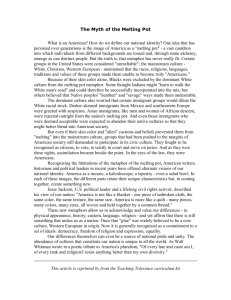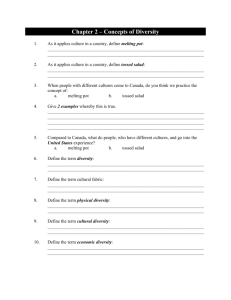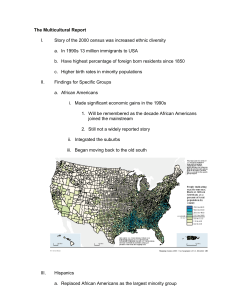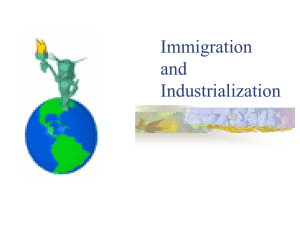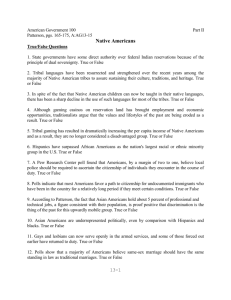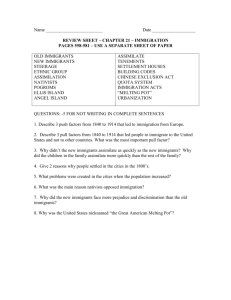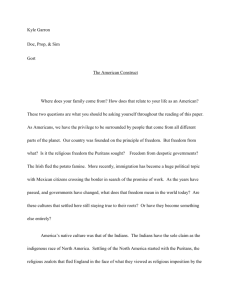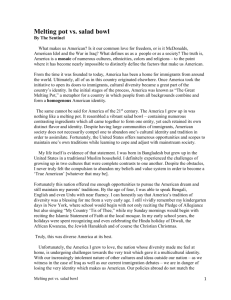An Examination of Ethnicities in the United States
advertisement
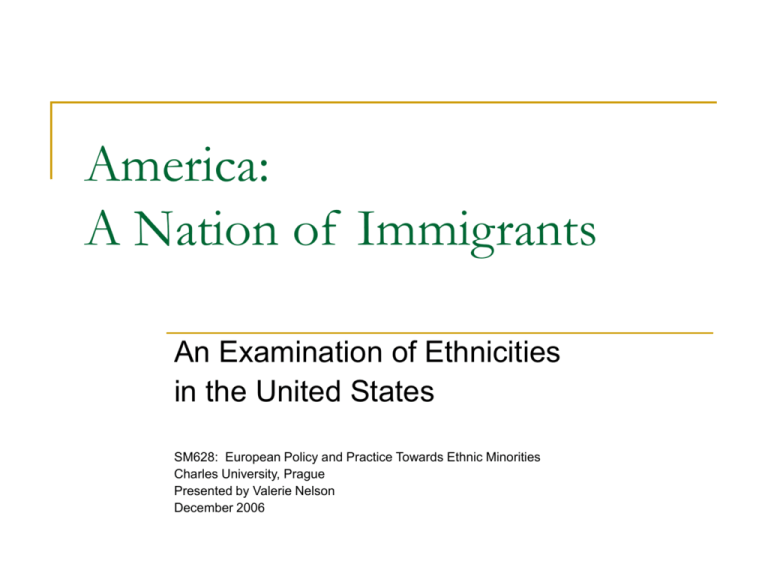
America: A Nation of Immigrants An Examination of Ethnicities in the United States SM628: European Policy and Practice Towards Ethnic Minorities Charles University, Prague Presented by Valerie Nelson December 2006 A History of Immigration American Indians – 1600s 1st Wave of Immigrants – early 1800s European Ellis Island: 12 million immigrants from 1892 to 1924 2nd Wave of Immigrants – 1970 Hispanic Asian History of Blacks in America Dred Scott decision – 1857 American Civil War – 1861 to 1865 Slavery led to economic, political, power issues Emancipation Proclamation – 1862 Abolished slavery 14th Amendment – 1868 No rights for slaves Limited citizenship Equal protection Plessy v. Ferguson – 1896 Separate but equal Civil Rights Movement Arose in 1950s Brown v. Board of Education – 1954 Martin Luther King, Jr. “I have a dream…” speech Civil Rights Act – 1964 Overturned Plessy v. Ferguson Equal Employment Opportunity: Equal rights, regardless of race, gender, religion Affirmative Action – 1970s Apply with scrutiny - 1995 African American Icons Activists / Politicians Sojourner Truth Ida B. Wells Frederick Douglass Thurgood Marshall Malcolm X Martin Luther King, Jr. Intellectuals Langston Hughes Maya Angelou Toni Morrison Entertainers Rosa Parks Sports Harriet Tubman Hank Aaron Jesse Jackson Jackie Joyner-Kersee Clarence Thomas Sugar Ray Leonard Colin Powell Jackie Robinson Condoleeza Rice Muhammad Ali Michael Jordan Tiger Woods Music Chubby Checker Miles Davis Sammy Davis, Jr. Nat King Cole Duke Ellington Jimi Hendrix Dizzy Gillespie Ray Charles Louis Armstrong Billie Holiday Chuck Berry America’s Minorities Today Hispanics Blacks 39.7 million; 13% Asian Americans 42.6 million; 14% 14.4 million; 5% American Indians 4.5 million; 1.5% Social Disparities Education Minority high school graduates versus Caucasian (81%) Blacks: 74% American Indians: 76% Asian Americans: 87% Hispanics: 58% Social Disparities Economics Blacks American Indians 35% lower incomes versus Caucasians 25% at poverty level Asian Americans 8% unemployment 40% lower incomes versus Caucasians 25% at poverty level 33% higher incomes versus national median 11% at poverty level Hispanics 22% at poverty level 20% lower income versus national median Social Disparities Health Blacks 24% on public insurance Substantially higher at risk American Indians Various barriers to health care Asian Americans Substantially less at risk Women have highest life expectancy of all US groups (85.8 yrs) Hispanics Barriers to health care America, the ‘Melting Pot’ Early 1900s Israel Zangwill Play proposed “the promise that all immigrants can be transformed into Americans, a new alloy forged in a crucible of democracy, freedom and civic responsibility.” (Booth 1998) America, the ‘Melting Pot’ National motto: E pluribus unum Making one out of many Historical influences Herman Melville Ralph Waldo Emerson Federation compounded of all tribes and people “Smelting” Included “all the European tribes … the Africans & the Polynesians.” John Quincy Adams “Casting off the European skin, never to resume it” America, the ‘Melting Pot’ The ‘hyphenated-American’ Political correctness – 1990s Preservation of ethnic and cultural characteristics No need for assimilation to merge with majority America, the ‘Melting Pot’ Ethnical neighborhoods NY, San Francisco, LA, Chicago Labor market niches Hispanics – domestic/manual labor Koreans – small businesses African Americans – business, politics A Different Nation, Today Test of the ‘Melting Pot’ 2nd wave of immigrants bring varied cultures Previously, greater consensus on ‘America’ Today, more emphasis on cultural roots Demographic Shift No one ethnic group – including whites of European descent – will comprise a majority of the nation's population (Booth 1998) U.S. Census Bureau Hispanics will likely surpass blacks early in 21st century By 2050 Hispanics: 25% Blacks: 14% Asians: 8% Whites: 53% (Booth 1998) The Future America Separate, disconnected communities 1. No sense of commonality Modified pluralist society 2. Core ideas of citizenship, capitalism Little interaction Sources Booth, William. “The Myth of the Melting Pot.” The Washington Post. 22 February 1998. 28 November 2006. <http://www.washingtonpost.com/wp-srv/national/longterm/meltingpot/melt0222.htm..> “Melting Pot.” Wikipedia: The Free Encyclopedia. 28 November 2006. 30 November 2006. <http://en.wikipedia.org/wiki/Lithuania.> Smoler, Frederic. “What Should We Teach Our Children About American History?” American Heritage.com. Vol. 33, Issue 1, February/March 1992. 28 November 2006. <http://www.americanheritage.com/articles/magazine/ah/1992/1/1992_1_45.shtml.> “Black History Month.” History.com. 2006. 28 November 2006. <http://www.history.com/minisites/blackhistory/.> “American Civil War.” Wikipedia: The Free Encyclopedia. 1 December 2006. 1 December 2006. <http://en.wikipedia.org/wiki/American_Civil_War.> “Fourteenth Amendment to the United States Constitution.” Wikipedia: The Free Encyclopedia. 1 December 2006. 1 December 2006. <http://en.wikipedia.org/wiki/Fourteenth_Amendment_to_the_United_States_Constitution.> “Statue of Liberty National Monument.” History.com. 2006. 28 November 2006. <http://www.history.com/encyclopedia.do?articleId=227261.> “Immigration.” History.com. 2006. 28 November 2006. <http://www.history.com/encyclopedia.do?articleId=212582.> “Minority Populations.” Office of Minority Health.” 28 November 2006. <http://www.omhrc.gov/templates/browse.aspx?lvl=1&lvlID=5.> Schlesinger, Arthur M. The Cycles of American History. New York: Houghton Mifflin Company, 1999. Biskupic, Joan, and Elder Witt. The Supreme Court & Individual Rights 3rd edition. Washington, D.C.: Congressional Quarterly, Inc., 1997.
